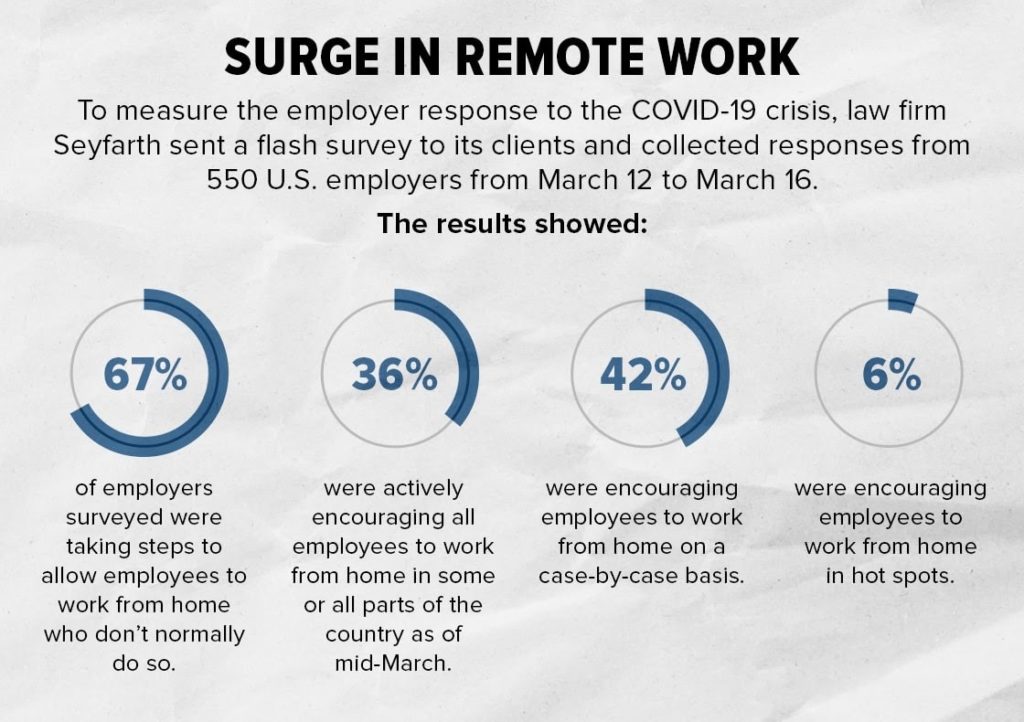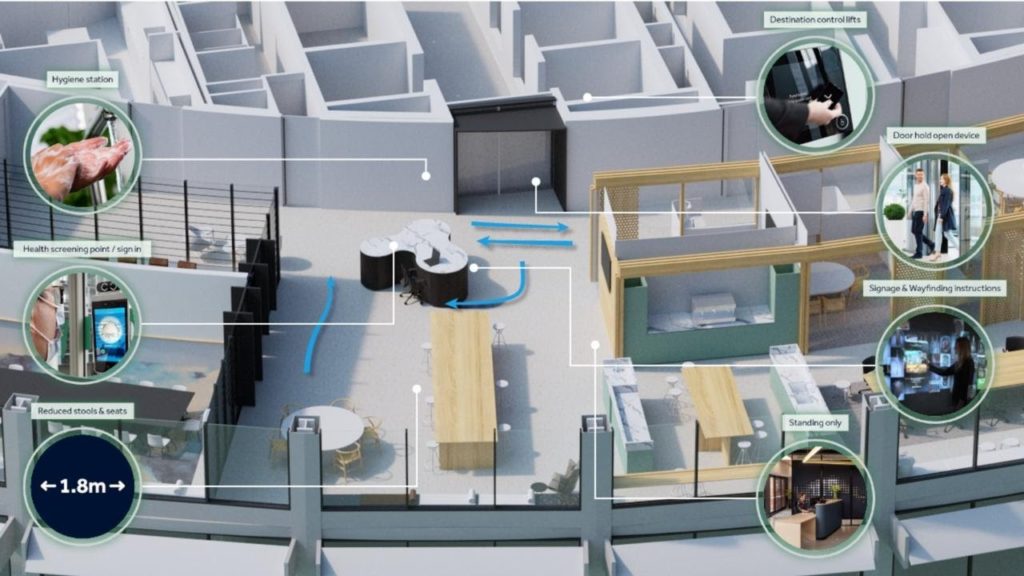What’s the ‘New Normal’ in the Future of Work?
The future of work looks to have changed not by happenstance. Who would have thought that it would take a pandemic and not advanced technology to change our lives and how we work? With the rest of the world, we watched in disbelief as the COVID-19 pandemic took hold early in 2020 and changed life as we knew it. Among the most radical changes was the transition from in-office to remote working. The sudden increase in work-from-home created a cause for global discussion regarding best practices for bringing workforce teams together from multiple locations.
So, what is the future of work? What changes could be in store for the workplace, the workforce, and the nature of work itself? It is time to explore technologies like automation, robotics, and artificial intelligence to shape how we work, where we work, and how humans fit into that landscape.
Remote Working – Be Careful What You Wish For!
Pre-COVID19, many working Americans yearned for a way to work remotely and stop the daily drudgery of the work commute. Sitting in traffic is no one’s idea of a productive way to spend an hour or two each day. According to a new MIT report, 34 percent of Americans who previously commuted to work, reported that they were working from home by the first week of April 2020, due to the coronavirus (Molla, 2020).

While a lot of businesses have already started adapting to remote work pre-pandemic, for others, it’s still a new concept with workers having to navigate while adhering to social distancing measures. This transition puts a spotlight on how remote work and collaboration will be the future of business continuity. And in the short-term, businesses can reduce operating costs by permitting workers to work from home, which is less painful than layoffs.
Business leaders are also adjusting to new ways of leading teams. To help create best practices, companies are making the transition to technological change by providing training and guidelines and instruction for working remotely. For some, it’s a leap. Workers will need new skillsets on tracking productivity, interacting with supervisors and managers and staying engaged and accountable.
Where Are You in Your Digital Transformation?
Since 2018, we have witnessed great change in the speed and scale of technological advances, bringing bigger and bolder shifts in shorter windows of time (Vollina et al.,2020).
The COVID19 pandemic presents a unique opportunity for organizations to integrate AI and automation into automatable tasks and erase the belief that humans and machines are on parallel paths. We find author’s like George Danner, an AI and automation pioneer, giving stakeholders practical and vital precedent on what is to come in his book, “The Executive’s How-to-Guide to Automation”, Palgrave Macmillan. According to Danner, “Automation is coming and there’s nothing you can do to stop it.” (Danner,2019). The book is a primer on what leadership should be doing now to embrace the tsunami of AI that is approaching.
The necessity of working from home brought on by the pandemic created a panicked spend on technology like video conferencing subscriptions as well as equipment with cameras and video capabilities and increased internet bandwidth to handle the uptick in broadband demand.
Social Distancing’s Effect on Teams
Big or small, businesses are still trying to figure out the best way to maintain team communication, morale, and motivation. Now that we have experienced distance learning and remote team collaboration – it is important to find ways to share detailed information and creativity from notes and presentations to whiteboarding. The benefits of going digital gives us an opportunity to record meetings for archiving important information and to share with others who were absent for the original collaboration to add their comments and thoughts. Moving to digital meetings allows a broader audience to take part in productivity in a new way of thinking which we believe will encourage more innovation.
Be Prepared to Return to the Office, Differently!
The thought of returning to offices can feel like a fresh start. Some of us are essential employees and are required to return, but not everyone will. Although it’s a bit early for America’s workforce to know the exact timeline, companies must start preparing for the return of employees to the physical workplace. The pandemic has opened the floor for business leaders to do three things: prepare to return to work, understand and leverage the advancements they enacted during the crisis, and chart a new path forward.
Self-isolation and quarantining during the pandemic may have affected your employees’ mental health. HR teams should be aware and create a contingency plan for the potential effects, providing resources ready to help (Snook).
Companies should also consult and continue monitoring guidelines and recommendations issued by federal agencies and state and local municipalities. Here is the guidance published by the U.S. Centers for Disease Control and Prevention (CDC) and the Occupational Safety and Health Administration (OSHA), which outlines critical considerations for planning and preparing workplaces for bringing back employees:
Implementing First Line of Preventive Measures: Educate employees on preventive measures to reduce the risk of spreading COVID-19; support good hygiene practices, and provide employees, customers, and workplace visitors with a designated area to wash or sanitize their hands. Also, establish policies and practices for social distancing and perform routine environmental cleaning and disinfection.
Implementing Workplace Controls: Increase ventilation rates in the workplace; install high-efficiency air filters; establish policies to limit the number of employees and visitors in the workplace at any given time; reconfigure office spaces to maintain proper social distancing; set up barriers, such as partitions, between workspaces; and provide personal protective equipment (e.g., masks, gloves, and protective eyewear) and training and education on the proper use of such protective wear.
Prompt Identification and Isolation of Employees Suspected of COVID-19: Conduct health/body temperature screenings as a mandatory condition to enter the workplace; encourage employees to self-monitor for signs and symptoms of COVID-19, and develop policies and procedures for employees to report when they are sick or experiencing symptoms of COVID-19 (Cannon et al., 2020).
In the longer term, experts predict that society’s heightened awareness of contagious diseases could usher in a new type of office – one that has elements in common with a hospital. Post pandemic office spaces can have sanitizing booths, automated operations, distant seats, digital signs, etc. (Mudditt,2020).

Build A Sustainable Post-COVID Future
If this pandemic has taught us anything, it’s about overcoming leaping change and challenges. Each of us, including businesses and government, needs to take ownership of the future of work. Health and safety now rank along with purpose, potential, perspective, profits and possibility for our future.
Survival of the fittest is a harsh reminder of what happens to businesses that don’t create new roadmaps and paths towards the future. Organizations must return to a post-COVID world, adapting and changing. Building a sustainable version of the new human work model includes social distancing as a strategy rather than a requirement.
About TechQuarry
We are Human-Centric Tech Amplification
Our innovative team of thought leaders brings a holistic and balanced approach to IT and the deep insight needed to enable your people to capitalize in our world of continuous technological advancement.
We’ll help you create a positive, frictionless, technology-savvy taskforce who step-ups in times of need. Visit our website https://www.techhumanit.com/tech-solutions/ to see how we implement digital technology success and sustainability. People first.

Javier Guerra
Javier Guerra is a co-founder of TechQuarry®, a people-centric business transformation consultancy and technology staff-augmentation service provider focused on helping companies evolve in the new age of IT. He applies human-behavioral scientific methods and employs seasoned experts to help organizations transform through technology innovation, optimization, talent attraction, and retention.You can find him here on LinkedIn
_______________________________________________________________________________________________________________________________________________________________________
Works Cited
Cannon, John, et al. “Key Considerations in Designing a Return to Work Plan.” Shearman & Sterling, 8 May 2020, www.shearman.com/perspectives/2020/04/key-considerations-in-designing-a-return-to-work-plan-covid-19.
Danner, George. “The Executive’s How-to-Guide to Automation.” Palgrave Macmillan, 2019.
Molla, Rani. “This Is the End of the Office as We Know It.” Vox, Vox, 14 Apr. 2020, www.vox.com/recode/2020/4/14/21211789/coronavirus-office-space-work-from-home-design-architecture-real-estate.
Mudditt, J. “How Offices Will Change after Coronavirus.” BBC Worklife, BBC, 15 May 2020, www.bbc.com/worklife/article/20200514-how-the-post-pandemic-office-will-change.
Snook, A. “Key Considerations in Designing a Return to Work Plan.” Shearman & Sterling, 8 May 2020, www.shearman.com/perspectives/2020/04/key-considerations-in-designing-a-return-to-work-plan-covid-19.
Vollina, E., et al. “Returning to Work in the Future of Work.” Deloitte Insights, 15 May 2020, www2.deloitte.com/us/en/insights/focus/human-capital-trends/2020/covid-19-and-the-future-of-work.html.
Zeidner, Rita. “Coronavirus Makes Work from Home the New Normal.” SHRM, SHRM, 23 Mar. 2020, www.shrm.org/hr-today/news/all-things-work/pages/remote-work-has-become-the-new-normal.aspx.




Leave a Reply